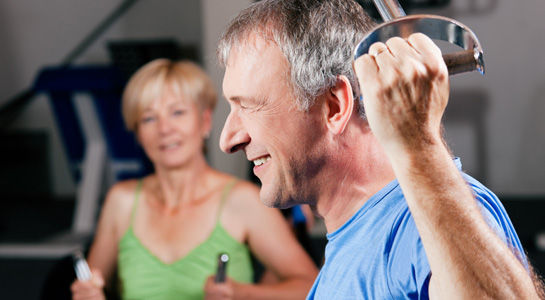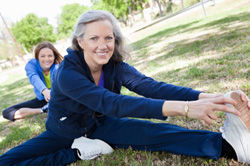
By CARRIE MYERS
As we age, our bodies decline in function, especially if we’re not taking precautions against it. The same goes for the brain. While it was once believed that the brain was hardwired during childhood and there was nothing you could do to change that, today we know that the brain is plastic in nature, able to form new cells and neural connections. As a fitness professional, you are in a perfect position to help older adults effectively exercise their brains along with their bodies, thereby creating the ultimate mind-body connection.
Neuroplas-what?
“With aging, a loss of synapses may contribute to a slowing in the speed of cognitive processing, including thought and mental recall,” says Janie Clark, M.A., president of the American Senior Fitness Association and author of "Brain Fitness for Older Adults," a continuing-education course for fitness professionals. “However, we can mitigate the degenerative cognitive loss commonly associated with normal aging by encouraging neuroplasticity.”
Neuroplasticity is the ability of the brain to change, adapt and even rewire itself based on new experience. One issue with seniors, however, is that they tend to fall into routines and either avoid or do not have the opportunity to experience new activities or events.
“Many seniors never change their experience. They do the same things all the time and seem to be afraid to do anything different,” says Carolyn Dean, M.D., N.D., medical director of The Nutritional Magnesium Association. “That fear keeps them from engaging in new experiences that could help foster neuroplasticity.”
If you work with this population, you are already setting them on the track to neuroplasticity, because exercise alone has been shown to improve brain health.
“Large epidemiologic studies have shown that middle-aged and senior people who exercise regularly experience less age-associated cognitive decline,” says Catherine Sarkisian, M.D., a geriatrician and researcher at the David Geffen School of Medicine at UCLA. “We also know from randomized trials of aerobic exercise programs that people who improve their cardiac fitness are also more likely to improve their cognitive function, especially in the domains of cognitive speed and attention. One reason for this is because blood flow to your brain increases with the increased cardiac output from the aerobic exercise.

“Aerobic exercise in turn prevents cardiovascular disease and diabetes,” Sarkisian continues, “both of which are risk factors for dementia, so it makes sense that people who maintain excellent cardiac fitness are at lower risk of [developing dementia].”
But it goes further than that. There are even specific changes within the brain itself. “When participating in cardio exercise, the brain releases and increases the brain-derived neurotrophic factor (BDNF) level, which is like Miracle-Gro for new brain cells, forming new cells, neural pathways and connections,” explains Aneil Koerper, C.S.C.S., health and fitness coordinator for The Terraces of Phoenix in Phoenix, Ariz.
“Research suggests that physical fitness may foster cognitive health through more than one mechanism,” adds Clark. Besides stepping up the secretion of BDNF, “it also appears to increase the rate of neurogenesis—the actual creation of new neurons—across one’s lifespan. It also improves circulation while increasing the oxygen-carrying capacity of one’s blood; enhanced blood flow to the brain has been linked to corresponding improvements in cognitive functioning.”
Mark Poisall, M.S., C.S.C.S., a behavioral specialist for Medifast, Inc., cites a 2006 study by Colcombe et al. in which 59 older adults were randomly assigned to either a cardiovascular exercise group or a nonaerobic exercise control group in which they did only stretching and strength training. Participants exercised for three hours a week for six months. Their brains were scanned before and after the training period.
After six months, the brain volume of the aerobic-exercising group increased in several areas compared to the control group. Volume increase occurred primarily in frontal and temporal areas of the brain, which are involved in executive control and memory processes. (See sidebar, “What Parts of the Brain Benefit Most From Exercise?”)
“The authors do not know what underlying cellular changes might have caused these volume changes,” says Poisall. “However, they suspect, based on animal research, that volume changes may be due to an increased number of blood vessels and an increased number of connections between neurons.”
What Parts of the Brain
Benefit Most From Exercise?
The entire brain benefits from physical activity, but it appears to especially enrich functions based in the prefrontal and frontal regions of the brain. “This was reinforced by an exercise-versus-medication study conducted by a team of Duke University researchers,” explains Clark. Researchers measured 84 clinically depressed middle-aged and older subjects at baseline and again after four months in a variety of cognitive domains. Compared to the medication users, the exercisers had greater improvements in memory, as well as in executive functions pertaining to planning, organization and intellectual multitasking.
Source: Khatri, P. et al. (2001).
Effects of exercise training on cognitive functioning among depressed older men and women.
Journal of Aging and Physical Activity, 9, 1, 43–57.
Tease the Brain
While aerobic exercise alone appears to benefit the brain, some programs, including The Terraces of Phoenix, are adding brainteaser activities to their exercise programs to further improve the brain’s potential toward neuroplasticity.
“We decided to add brain teasers to our residents’ cardio routines to improve their memory and hearts at the same time,” says Koerper. “During the new fitness class, ‘Heart and Mind Cycle,’ older adults cycle on a recumbent bike while [our trainers] give them brainteasers. This has been very popular among our residents.”
Vista del Monte, a front-porch retirement community in Santa Barbara, Calif., takes a similar approach. “We’ve just begun offering ‘Brain Fitness Classes’ as part of the programming from the fitness and aquatic center,” explains Peggy Buchanan, M.A., director of fitness aquatics and physical therapy at Vista del Monte. “These one-hour classes begin with simple dance steps, then incorporate word games, puzzles and memorization techniques, along with a brief PowerPoint presentation explaining how exercise, nutrition and socialization stimulate cognition, delaying the onset of dementia.”
The Bottom Line
The aging population offers you a wonderful opportunity to help people improve their quality of life at a time when they may be facing increasing challenges performing activities that were once automatic and done with ease. The brain is an amazing organ that has the ability to adapt, grow and change—at every age. The outdated adage that “old dogs” can’t learn new tricks has no application to the older adult who is willing to continue to engage in physical activity and partake in new experiences.
Easy Ways to Tease the Brain

You can easily begin incorporating brain exercises into your clients’ or participants’ routines today. Consider trying the following techniques for challenging your clients’ brains:
- Encourage them to do a crossword puzzle, word find, math problems, or Sodoku while on the exercycle.
- Have participants alternate five minutes of brainteasers with 10 minutes of aerobic activity.
- Play a Wii Fit™ game that requires a client to do math and jump at the same time.
- Educate your clients about the muscles they are using during each exercise and quiz them during their sessions to see if they remember the names.
- Play a game of Simon Says, incorporating physical activity into the game. Incorporate activities that require clients to take directions, such as dance, tai chi and yoga, as these create a greater challenge for the brain.
- Bat a balloon back and forth. To increase the challenge, make a rule that they have to alternate hands, or tell them before they hit the balloon back to you which hand they have to use.
- Incorporate exercises that require clients to think left to right and diagonally. For example, have the client assume a standing or seated position on a stability ball and:
- hold a 1- to 4-pound soft medicine ball in each hand. Hold arms out to the sides at shoulder height. Adduct the extended arms to the body’s midline, open the arms back up, and then bring the extended arms up overhead and back down to the starting position. Repeat for eight to 12 repetitions.
- position the extended arms so that they are at a diagonal to the body, with one arm up and one arm down. Hold a 1- to 4-pound soft medicine ball in one hand. Close the arms, bringing them both to chest height, and move the ball to the opposite hand. Continue to exchange the ball in this manner for eight to 12 reps and then switch the direction of the diagonal and repeat.
- position the arms in the same manner as the previous exercise, but hold the ball in the top hand. After you exchange the ball to the other hand, switch the direction of the diagonal, so that the ball is always in the top hand. Repeat for eight to 12 reps.
 Carrie Myers has a bachelor’s degree in exercise science and has been a freelance writer for more than 11 years. She is the author of the award-winning book, Squeezing Your Size 14 Self into a Size 6 World: A Real Woman's Guide to Food, Fitness, and Self-Acceptance and presents, teaches and trains in New Hampshire and Vermont.
Carrie Myers has a bachelor’s degree in exercise science and has been a freelance writer for more than 11 years. She is the author of the award-winning book, Squeezing Your Size 14 Self into a Size 6 World: A Real Woman's Guide to Food, Fitness, and Self-Acceptance and presents, teaches and trains in New Hampshire and Vermont.